|
| Maryland Civil War Battlefield Map |
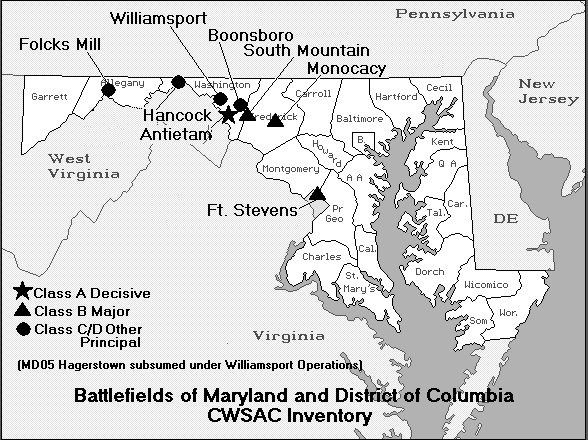
|
| Maryland Civil War Map of Battles |
Maryland witnessed and experienced fierce "Raids, Operations, and
Campaigns", with its most notable Civil War battles fought at Antietam (aka Sharpsburg); Boonsboro; Folck's Mill; Hancock; Monocacy; South Mountain; Williamsport; and Fort Stevens.
Introduction: In the American Civil War (1861-1865),
Maryland, a slave state, was one of the Border States straddling the South and North. Due to its location and a desire from both opposing
factions to sway its population to their respective causes, Maryland played an important role in the Civil War. The first
fatalities of the war happened during the Baltimore Riot of 1861, and the single bloodiest day of combat in American military
history occurred near Sharpsburg, Maryland, at the Battle of Antietam, a strategic Union victory which provided the opportunity
for President Abraham Lincoln to issue the Emancipation Proclamation. The 1864 Battle of Monocacy helped delay a Confederate
army bent on striking the Federal capital of Washington, D.C.
Background: "After the firing on Fort Sumter by the
rebels in April 1861, it became known that troops from the Northern states had been ordered to the defense of the nation's
capital, and that these troops would pass through Maryland. The secession leaders asserted that the defense of Washington
was but a pretense, the real object of the administration being the military occupation of Maryland in order to prevent its
secession."
"This rumor still further inflamed the public mind, and when about 2 p.m.
on April 18, 1861, six companies of Pennsylvania volunteers arrived in Baltimore, their march from the corner of Howard and
Cathedral streets to the Mount Clare station was made through an excited populace, who amused themselves with singing 'Dixie,'
cheering for the Southern Confederacy and jeering the unarmed soldiers. No assault was made, but the troops were jostled about
by the crowd and greeted by groans and hisses along the entire line of march. About noon on the 19th the 6th Mass. and Small's
'Washington' brigade, of Philadelphia, arrived at Baltimore en route to the nation’s capital. Just before daylight on
Sunday morning, April 21, Gen. B. F. Butler arrived at Annapolis with the 8th Mass. infantry, and was joined there 24 hours
later by Col. Lefferts with the 7th N.Y."
In addition to the U.S. soldiers arriving by land, others arrived in
Maryland by sea. Thereafter, Union frigates and vessels began arriving at Maryland ports and delivered their cargo of additional
Union troops. Although Maryland was a 'United State' and had not seceded, President Lincoln had authorized Gen. Scott
to suspend the privilege of the writ of habeas corpus, and directed him to arrest or disperse the Maryland legislature in
case it attempted any legislation favorable to the cause of secession.
| Maryland Civil War Map |
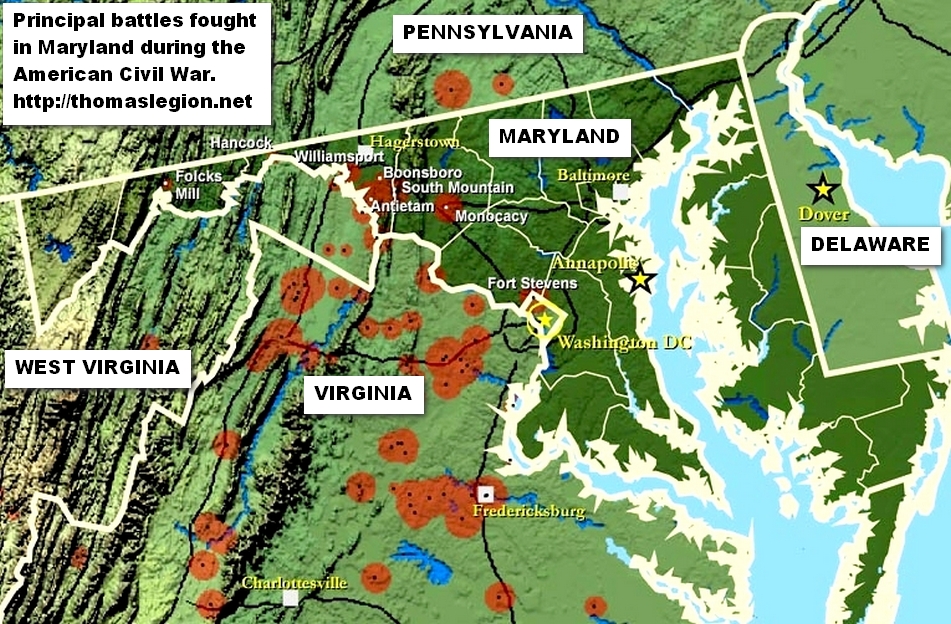
|
| Maryland Civil War Map of Battles |
"By orders from President Lincoln, Maryland, a free and democratic state,
had been overrun by Union soldiers. And under Lincoln's suspension of the writ of habeas corpus, Mayor Brown, Marshal Kane,
and several members of the legislature, among them Ross Winans and Coleman Yellott, were arrested and confined in military
prisons. Our democracy had been replaced by despotism." On March 6, 1862, Maryland witnessed the passage of the act known
as the "Treason Bill," which provided that the penalty of death should be inflicted on any one convicted of levying "war against
this state, or shall adhere to the enemies thereof, whether foreign or domestic, giving them aid or comfort, within this state
or elsewhere." See also Maryland in the American Civil War (1861-1865).
Civil War: According to the 1860 U.S. census,
Maryland had a free population of 599,860 and an additional slave population of 87,189. Approximately 65,000* Maryland
men served in the Union Army during the Civil War, while nearly 30,000 Marylanders joined the Confederate Army.
To help ensure Maryland's inclusion in the Union, President Lincoln suspended several civil liberties, including the writ
of habeas corpus, an act deemed illegal by Maryland native Chief Justice Roger Taney. Lincoln ordered U.S. troops to
place artillery on Federal Hill to threaten the city of Baltimore, and helped ensure the election of a new pro-union governor
and legislature. Lincoln went so far as to jail certain pro-South members of the state legislature at Fort McHenry, including
the Mayor of Baltimore, George William Brown. The grandson of Francis Scott Key was included in those jailed. The constitutionality
of these actions is still debated.
The first bloodshed of the Civil War occurred in Maryland. Concerned about
the Confederates capturing the capital, Washington, D.C., President Lincoln ordered troops to defend the city. They were transported
by rail to Baltimore, where they had to disembark, march through the city, and board another train to continue their journey
south to Washington. As one Massachusetts regiment was transferred between stations on April 19, 1861, a mob of secessionists
and Southern sympathizers attacked the train cars and blocked the route. The mob began throwing stones and bricks at the troops.
Panicked by the situation, several soldiers fired into the mob, and chaos immediately ensued as a giant brawl began between
fleeing soldiers, the violent mob, and the Baltimore police who tried to suppress the violence. Four soldiers and twelve civilians
were killed in the riot. This event inspired James Ryder Randall to write a poem which would be put to music and eventually
become the state song, "Maryland, My Maryland".
| Maryland Civil War Map |
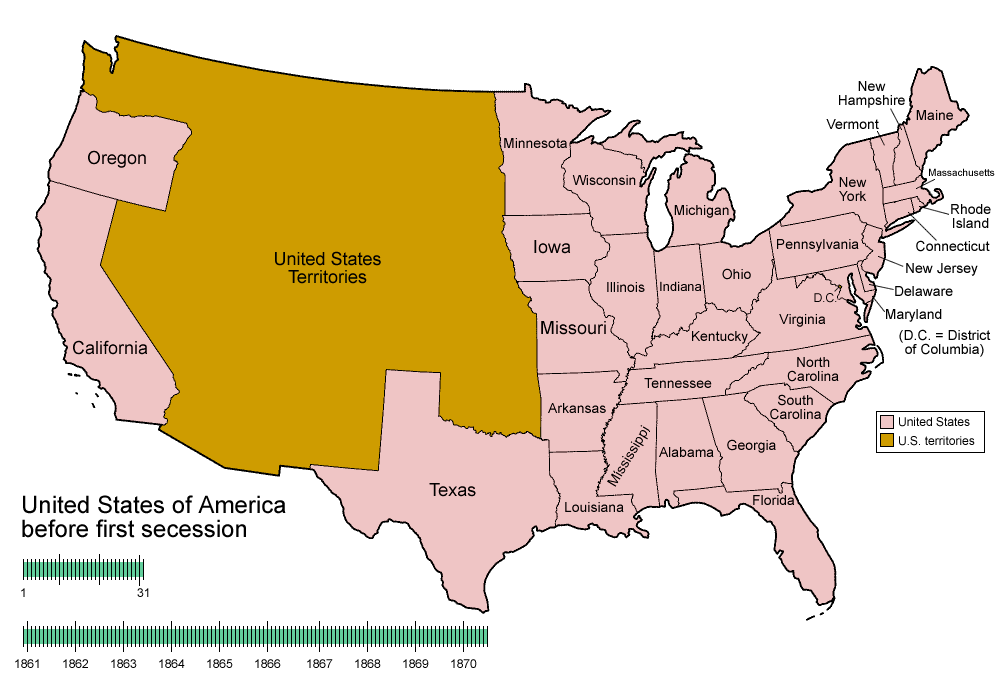
|
| Maryland Civil War Battle Timeline Map |
| Maryland Civil War Border State Map |
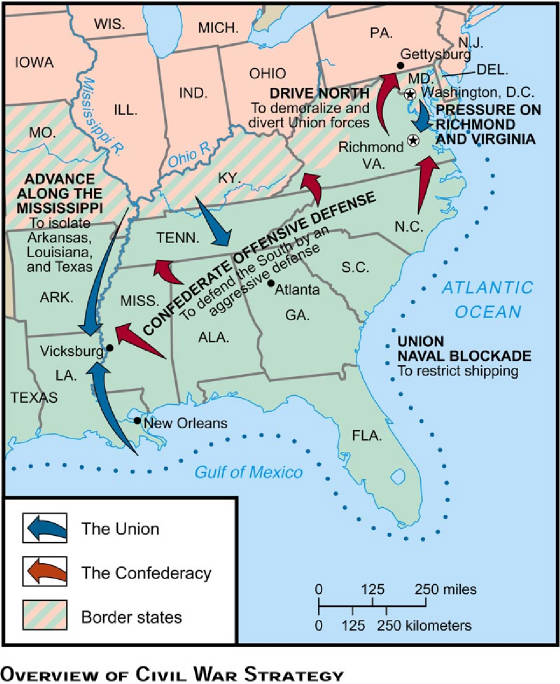
|
| Maryland Border State Map |
After the April 19 rioting, some small skirmishes continued in Baltimore
for the next month, but a sense of normalcy returned as the city was cleaned up. Mayor George William Brown and Maryland Governor
Thomas Hicks implored President Lincoln to reroute troops around Baltimore city and through Annapolis to avoid further confrontations.
On the evening of April 20, Hicks also authorized Brown to dispatch the Maryland state militia for the purpose of disabling
the railroad bridges into the city - an act he would later deny. One of the militia captains was John Merryman, who was arrested
without a writ of habeas corpus one month later, sparking the case of Ex parte Merryman.
Lincoln complied with the request to reroute troops to Annapolis at first.
However, on May 13, the Union army entered Baltimore, occupied the city and declared martial law, to prevent all further incidents.
The mayor, city council, and police commissioner, who were pro-South, were arrested and imprisoned at Fort McHenry. However,
in the case Ex parte Merryman, these actions were deemed unconstitutional.
After the occupation of the city, Union troops were garrisoned throughout
the state. Several members of the Maryland legislature were also unlawfully arrested, and the state was placed under Federal
martial law.
In the Civil War the largest
and most significant battle fought in the state was the Battle of Antietam, fought on September 17, 1862, near Sharpsburg.
The battle was the culmination of Robert E. Lee's Maryland Campaign, which aimed to secure new supplies; recruit fresh men
from among the considerable pockets of Confederate sympathies in Maryland; and to impact
public opinion in the North. With those goals, Lee's Army of Northern Virginia, consisting of about 40,000 men, had entered
Maryland following their recent victory at Second Bull Run. (See: Why Lee invaded Maryland and General Robert E. Lee's Proclamation
to the People of Maryland.)
While Major General George B. McClellan's 87,000-man Army of the Potomac
was moving to intercept Lee, a Union soldier discovered a mislaid copy of the detailed battle plans of Lee's army. The order
indicated that Lee had divided his army and dispersed portions geographically (to Harpers Ferry, West Virginia, and Hagerstown,
Maryland), thus making each subject to isolation and defeat in detail if McClellan could move quickly enough. McClellan waited
about 18 hours before deciding to take advantage of this intelligence and position his forces based on it, thus endangering
a golden opportunity to defeat Lee decisively.
The armies met near the town of Sharpsburg by the Antietam Creek. Although McClellan arrived in the
area on September 16, his trademark caution delayed his attack on Lee, which gave the Confederates more time to prepare defensive
positions and allowed Longstreet's corps to arrive from Hagerstown and Jackson's corps, minus A.P. Hill's division, to arrive
from Harpers Ferry. McClellan's two-to-one advantage in the battle was almost completely nullified by a lack of coordination
and concentration of Union forces, which allowed Lee to shift his defensive forces to parry each thrust.
| Maryland Civil War Battlefield Map |
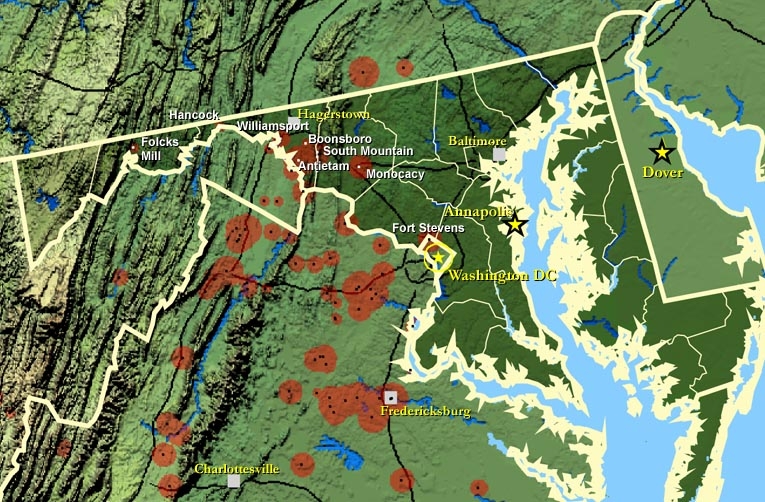
|
| Maryland Civil War Battle Map |
Although a tactical draw, the Battle of Antietam is considered a strategic
Union victory and a turning point of the war because it forced the end of Lee's invasion of the North and it allowed President
Lincoln to issue the Emancipation Proclamation, taking effect on January 1, 1863. Although Lincoln had intended to do so earlier,
he was advised by his Cabinet to make this announcement after a Union victory to avoid
the perception that it was issued out of desperation. The winning of the Battle of Antietam also may have dissuaded the governments
of France and Great Britain from recognizing the Confederacy; some suspected they were planning to do so in the aftermath
of another Union defeat. (Turning Points of the American Civil War.)
In 1864, elements of the warring
armies again met in Maryland, although this time the scope and size of the battle was much smaller than Antietam. The
Battle of Monocacy was fought on July 9, just outside Frederick, as part of the Valley Campaigns of 1864. Confederate forces
under Lt. Gen. Jubal A. Early defeated Union troops under Maj. Gen. Lew Wallace. The battle was part of Early's raid through
the Shenandoah Valley and into Maryland, attempting to divert Union forces away from
Gen. Robert E. Lee's army under siege at Petersburg, Virginia. However, Wallace delayed Early for nearly a full day, buying enough
time for Ulysses S. Grant to send reinforcements from the Army of the Potomac to the Washington defenses. See also Maryland in the American Civil War: A History.
Aftermath and Analysis: Because Maryland remained
in the Union, it was exempted from the anti-slavery provisions of the Emancipation Proclamation (The Emancipation Proclamation
only applied to states in rebellion). In 1864 the state held a constitutional
convention that culminated in the passage of a new state constitution. Article
24 of that document outlawed the practice of slavery. In 1867 the state extended suffrage to non-white males.
Maryland, as a slave-holding
Border State, had remained relatively neutral toward the south in the antebellum arguments over states’ rights and the
sovereignty of the Federal government. However, in the lead up to the American Civil War, it became clear that the state was
bitterly divided in its sympathies. There was much less appetite for secession than elsewhere in the Southern States, but
Maryland was equally unsympathetic toward the potentially abolitionist position of Republican candidate Abraham Lincoln. In
the presidential election of 1860, Lincoln won merely 2,294 votes out of a total of 92,421, or only 2.5% of the votes cast.
| Maryland Civil War Painting |
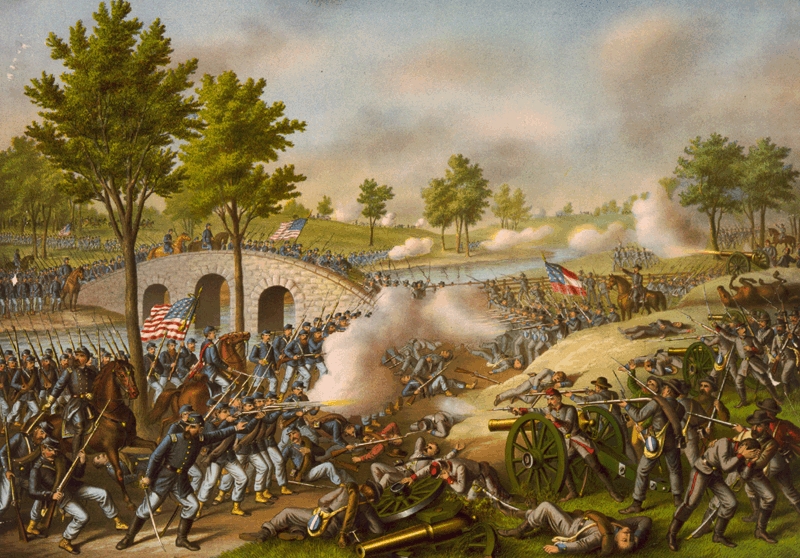
|
| Maryland and the Civil War |
(About) The Battle of Antietam on September 17, 1862 — the single bloodiest day of the American Civil
War and all of American military history, with nearly 23,000 casualties.
However, across the state, sympathies were mixed. Some northern Marylanders
such as John Wilkes Booth and General James J. Archer were pro-Confederate.
The political situation
in Maryland remained uncertain until May 13, 1861, when Union troops occupied the state, effectively preventing a vote in
favor of Southern secession. Federal soldiers led by General B. F. Butler entered Baltimore, occupied the city and declared
martial law to prevent any further incidents. Mayor Brown, members of the city
council and the police commissioner were arrested and imprisoned at Fort McHenry. One of the militia captains was John Merryman,
who was arrested and held in defiance of a writ of habeas corpus on May 25, sparking the case of Ex parte Merryman, heard
just 2 days later on May 27 and 28, in which the Chief Justice, Roger B. Taney, held that the arrest of Merryman was unconstitutional:
"The President, under the
Constitution and laws of the United States, cannot suspend the privilege of the writ of habeas corpus, nor authorize any military
officer to do so".
The immediate impact of
Merryman was however rather limited, as the government and the Army simply ignored the ruling. After the occupation of the
city, Union troops were garrisoned throughout the state. Several members of the Maryland legislature were also arrested. By
late summer Maryland was firmly in the hands of Union soldiers. Arrests of Confederate sympathizers soon followed causing
many Marylanders to flee to Virginia. Personal property was confiscated by the Federal government, while civil authority in
Baltimore was swiftly withdrawn from all those who had not been steadfastly in favor of the Federal government's emergency
measures.
Thousands of Union troops were
stationed in Charles County, and the Federal government established a large, unsheltered prison camp at Point Lookout at Maryland's
southern tip where thousands of Confederates were kept, often in harsh conditions.
Point Lookout is located
at a peninsula formed by the confluence of the Chesapeake Bay and the Potomac River at the southern tip of St. Mary's County,
Maryland.
| Maryland Civil War History |
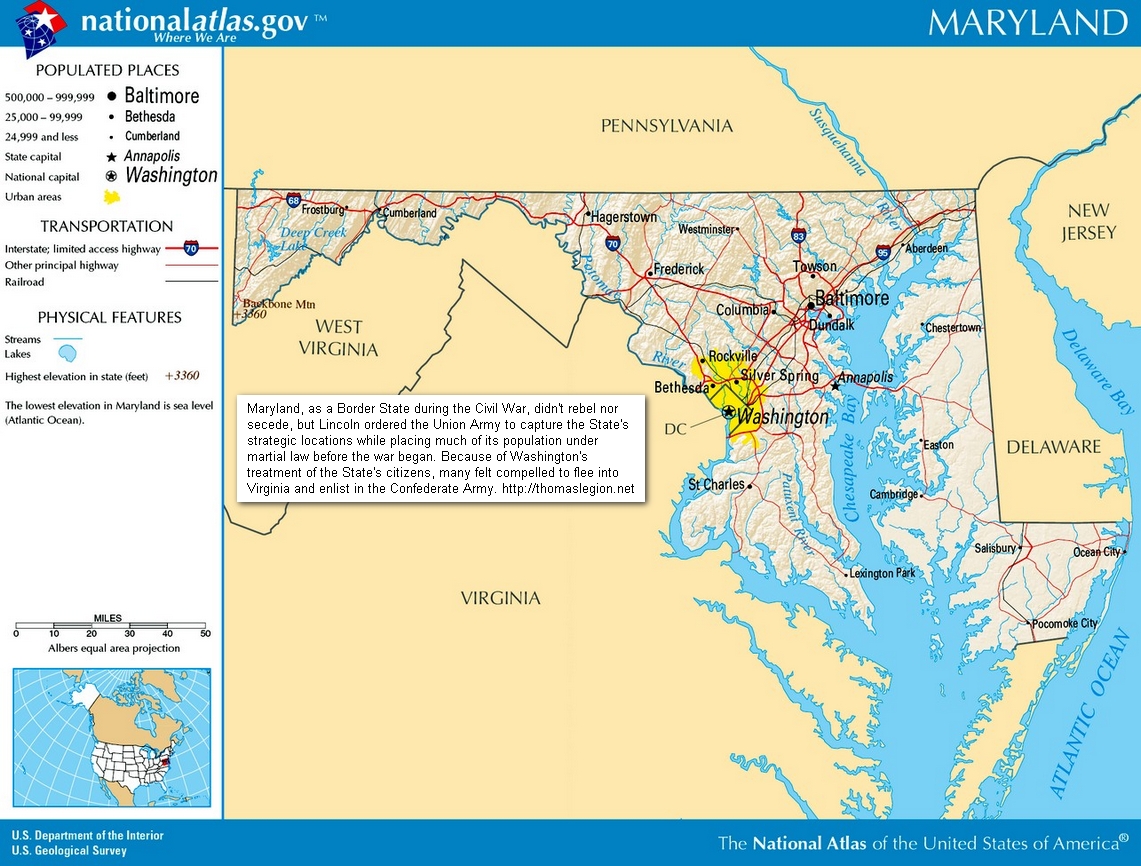
|
| Map of Maryland |
In 1862 during the American Civil War, much of the land around Point Lookout
was transformed into a bustling port, temporary city of civilians and military personnel and numerous buildings, a large army
hospital, an army garrison at Fort Lincoln, and a Union prison to hold Confederate prisoners of war. Of the 50,000 soldiers
held in the Union prison, aka Union prison camp, between 1863 and 1865, according to the Maryland Department of Natural Resources,
nearly 4,000 died. The camp, originally built to hold 10,000 men, swelled to as many as 20,000 prisoners after the exchange
of prisoners between armies was halted. It was the largest Union prison in the
North. See also Maryland in the American Civil War: A History.
*65,000 is an estimate since, depending on the source, totals vary slightly.
Estimates for Maryland, furthermore, range from 60,000 to 70,000 Union troops, which would include the following: Volunteers,
Militia, Marylanders serving in U.S. units (referred to as "regulars"), Navy, Marines, and nearly 9,000 colored troops. The Union Army, vol 2, p. 270, states the following: "From the beginning to the close
of the war Maryland furnished twenty regiments and one independent company of infantry; four regiments, one battalion and
one independent company of cavalry; and six light batteries — a total of 50,316 white troops — and six regiments
of colored infantry, numbering 8,718 men. In addition to these volunteers the state furnished her due proportion to the regular
army of the United States and 5,636 men to the navy and marine corps."
(Related reading and sources listed below.)
Related Reading - includes Raids, Operations, and Campaigns:
Sources: The Union Army; National Park Service; Library of Congress;
National Archives; Official Records of the Union and Confederate Armies; Maryland State Archives (16 Sept. 2004). Historical
Chronology; Dennis C. Curry (2001). "Native Maryland, 9000 B.C.-1600 A.D."; Whitman H. Ridgway. Maryland Humanities Council
(2001). "(Maryland in) the Nineteenth Century"; David Hein, editor. Religion and Politics in Maryland on the Eve of the Civil
War: The Letters of W. Wilkins Davis. 1988. Rev. ed., Eugene, OR: Wipf & Stock, 2009; Kurz & Allison. Copyrighted
1888 by Kurz & Allison, Art Publishers, Chicago, U.S.A.
|

